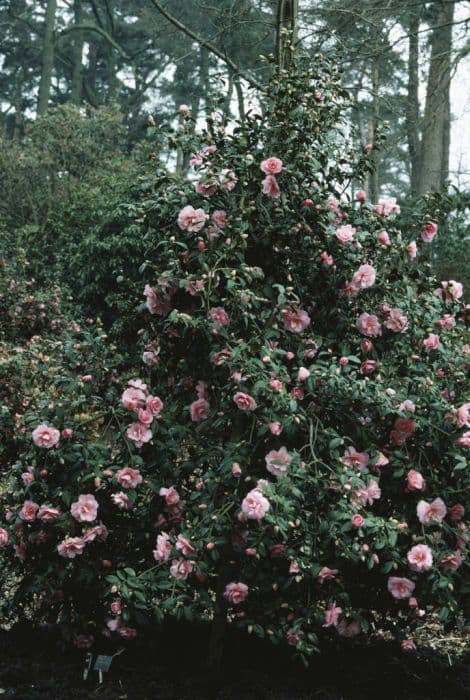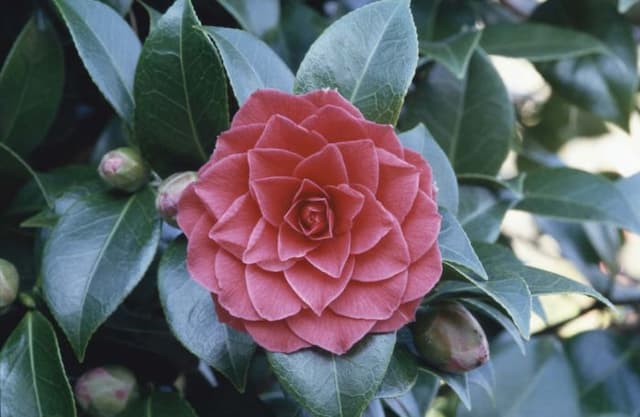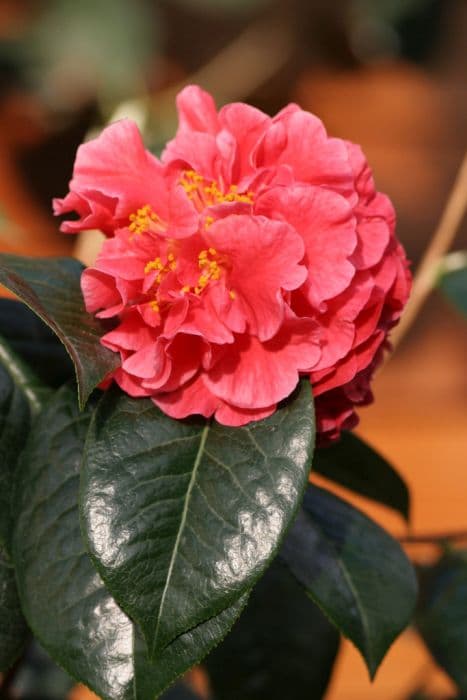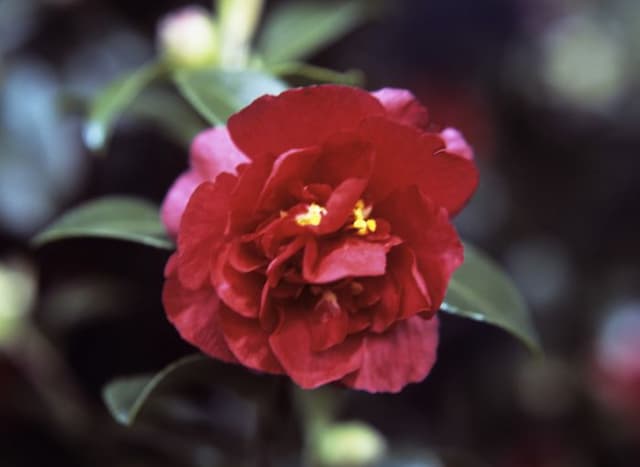Williamsii Camellia Camellia × williamsii 'J.c. Williams'

ABOUT
Camellia × williamsii 'J.C. Williams' is a striking flowering plant with lustrous, evergreen foliage. The leaves are glossy and deep green, providing a perfect backdrop for its spectacular blossoms. The flowers are the highlight of this plant, large and showy with a rounded form. They feature petals that are typically a soft shade of pink, though some may lean towards a pale, almost whitish hue with tones of deeper pink. The blooms of 'J.C. Williams' are made up of multiple layers of petals that create a full, peony-like appearance, and at the center, a cluster of golden stamens adds a lovely contrast. These stamens are prominent and add an extra touch of elegance to the flower's overall aesthetic. Overall, the appearance of Camellia × williamsii 'J.C. Williams' is that of a classic, romantic garden plant with a striking presence thanks to its glossy foliage and magnificent blooms that stand out in garden settings or as part of cultivated landscapes. Its evergreen nature ensures that it provides interest throughout the year, even when not in flower.
About this plant
 Names
NamesFamily
Theaceae.
Synonyms
Williams' Camellia, J.C. Williams Camellia.
Common names
Camellia × williamsii 'J.C. Williams'
 Toxicity
ToxicityTo humans
The Williams Camellia is generally considered non-toxic to humans. Ingesting parts of this plant typically does not lead to poisoning or severe adverse health effects.
To pets
The Williams Camellia is also generally recognized as non-toxic to pets. It should not cause any serious symptoms of poisoning if pets ingest parts of this plant. However, as with any non-food plant, consumption in large quantities could potentially lead to mild gastrointestinal upset.
 Characteristics
CharacteristicsLife cycle
Perennials
Foliage type
Evergreen
Color of leaves
Dark green
Flower color
Pink
Height
8-10 feet (2.4-3 meters)
Spread
6-8 feet (1.8-2.4 meters)
Plant type
Shrub
Hardiness zones
7-9
Native area
Asia
Benefits
 General Benefits
General Benefits- Ornamental Appeal: The Camellia x williamsii 'J.C. Williams' has showy flowers that add beauty to gardens and landscapes.
- Long Blooming Season: It typically has a long flowering period, providing color from fall to early spring.
- Evergreen Foliage: It maintains its glossy green leaves year-round, offering continuous visual interest.
- Tolerant of Partial Shade: Can grow well in partially shaded conditions, making it versatile for different garden locations.
- Drought Resistance: Once established, it has good tolerance to dry periods.
- Attracts Pollinators: The flowers attract bees and other pollinators, which are beneficial for the garden ecosystem.
- Low Maintenance: Generally requires minimal pruning and care once established.
 Medical Properties
Medical PropertiesThis plant is not used for medical purposes.
 Air-purifying Qualities
Air-purifying QualitiesThis plant is not specifically known for air purifying qualities.
 Other Uses
Other Uses- Camellia x williamsii 'J.C. Williams', commonly known as Camellia, can be used as a natural fabric dye, providing a range of colors from soft beiges to pinks depending on the mordant and fabric used.
- The fallen petals of Camellias can be scattered on the surface of ponds and water features for a decorative touch that reflects the beauty of the plant in a different medium.
- Camellia wood is hard and dense, making it suitable for crafting small objects like handles, buttons, or intricate carvings that require a fine grain and smooth finish.
- The Camellia's glossy evergreen leaves can be used in floral arrangements to add texture and a lush backdrop for more colorful flowers.
- When dried and pressed, the Camellia's flowers and leaves can be used in craft projects, such as creating bookmarks or decorating homemade cards and stationary.
- Camellia petals can be used for potpourri mixes, offering a subtle floral scent and adding color and variety to the mix.
- In Bonsai art, the Camellia can be cultivated and maintained as an ornamental specimen showcasing the traditional Japanese aesthetic in miniature form.
- Camellia blooms can inspire artists and photographers, providing a beautiful subject for their work that captures the essence of the plant in various artistic mediums.
- The trailing branches of the Camellia can be trained to grow horizontally on trellises, creating living, flowering walls that serve as privacy screens or garden partitions.
- The Camellia's seeds, when dried, can be incorporated into jewelry or decorative items as beads, taking advantage of their hard, smooth texture and round shape.
Interesting Facts
 Feng Shui
Feng ShuiThe Camellia is not used in Feng Shui practice.
 Zodiac Sign Compitability
Zodiac Sign CompitabilityThe Camellia is not used in astrology practice.
 Plant Symbolism
Plant Symbolism- Admiration: Camellia blooms express admiration towards the recipient, making it a suitable gift for someone you respect and hold in high esteem.
- Perfection: The exquisite form of the camellia flower symbolizes the ideal of perfect beauty, often representing the divine or something to be strived for.
- Longing: In some cultures, particularly in Japan (where camellias are called "tsubaki"), camellias can represent longing or desire for someone, symbolizing the deep yearning one may feel for a loved one.
- Love and Affection: Camellias are often associated with deep romantic love, affection, and devotion, making them a favored gift for romantic partners.
- Enduring Spirit: The camellia’s resilience and evergreen nature embody the enduring and unyielding spirit, suggesting strength and steadfastness in adversity.
 Water
WaterWilliamsii Camellias need consistent moisture, and it is essential to maintain evenly moist soil without letting it become soggy. During the growing season, water the plant with about 1-2 gallons per week, depending on the weather conditions. In hot, dry periods you may need to water 2-3 times a week, while in cooler, wetter conditions, once a week may suffice. Decrease watering in the winter when the plant is not actively growing, but do not allow the soil to dry out completely. Use a gentle stream of water to avoid disturbing the soil or damaging the foliage and flowers.
 Light
LightWilliamsii Camellias thrive in partial shade with dappled sunlight. They should be planted in a spot that is sheltered from the hot afternoon sun to avoid leaf scorch, but still receives bright, indirect light during the morning or late afternoon. An ideal location is underneath high-canopy trees that allow light to filter through, or on the north or east side of a building where it will receive moderate sunlight.
 Temperature
TemperatureWilliamsii Camellias prefer temperate climates and can generally tolerate temperatures as low as 10°F and as high as 90°F. However, the ideal temperature range for this plant is between 40°F and 80°F. To ensure flower buds are protected, avoid locations where the plant might be subjected to extreme cold or hot drafts.
 Pruning
PruningPrune Williamsii Camellias to maintain shape and health, typically after blooming ends in the spring. Remove any dead or damaged branches, inward-growing stems, and selectively thin the plant to encourage air circulation. Pruning can also stimulate new growth and promote more prolific blooming in the following season. Do this annually or as needed to keep the plant looking its best.
 Cleaning
CleaningAs needed
 Soil
SoilWilliamsii camellias require acidic soil with a pH of 6.0 to 6.5. A mix of equal parts well-draining ericaceous compost, pine bark, and perlite or sand is ideal, as these plants thrive in moist, well-aerated soil that is rich in organic matter.
 Repotting
RepottingWilliamsii camellias should be repotted every 2 to 3 years, preferably in the spring after flowering. Use a pot only slightly larger than the previous one to avoid stressing the plant.
 Humidity & Misting
Humidity & MistingWilliamsii camellias prefer moderate to high humidity levels, optimally between 40% to 60%. They thrive in moist air but not wet foliage, which can lead to fungal issues.
 Suitable locations
Suitable locationsIndoor
Place Williamsii camellias in bright, indirect light with high humidity.
Outdoor
Plant in partial shade, sheltered from cold winds, in acidic soil.
Hardiness zone
7-9 USDA
 Life cycle
Life cycleCamellia × williamsii 'J.C. Williams', also known as J.C. Williams camellia, begins its life cycle when seeds germinate in a warm, moist environment, emerging as seedlings with a pair of leaves. As it becomes a sapling, this evergreen shrub develops more leaves and starts to exhibit its characteristic glossy, deep green foliage. Over several years, the J.C. Williams camellia matures and reaches its flowering stage, usually in late winter to spring, producing showy flowers that can range from white to pink and sometimes have a mix of both colors. The flowers are pollinated by insects, leading to the production of seed capsules that, once mature, release seeds to start the next generation. This camellia can live for many decades, slowly growing over time to reach heights of up to 2.5 to 4 meters. Throughout its life, it requires well-drained, acidic soil and partial shade to thrive, and may undergo periods of pruning to shape the plant and encourage new growth.
 Propogation
PropogationPropogation time
Spring
For the camellia hybrid 'J.C. Williams', the most popular method of propagation is through semi-hardwood cuttings. This is typically done in late summer, after the new growth has begun to harden. Cuttings of about 4 to 6 inches (10 to 15 cm) in length, with several leaves attached, are taken from the parent plant. The lower leaves are removed, and the cut end is often treated with a rooting hormone to encourage root development. These cuttings are then placed in a moist, well-draining potting mix or propagating medium, and kept under conditions of high humidity and indirect light until roots develop, which can take several weeks to a few months. It's important to keep the medium consistently moist but not waterlogged to ensure the cuttings do not rot.









